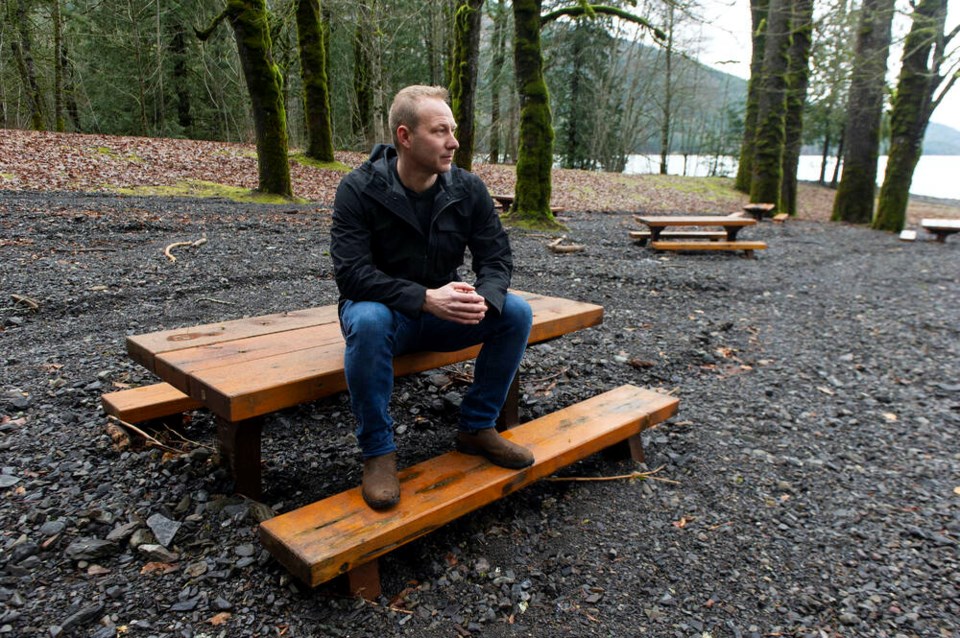Picnic tables buried in gravel. A bridge that now leads to nowhere. Trails and access roads obliterated by water, rock and mud.
In social media posts, backcountry users have started to catalogue the damage caused by a series of “atmospheric rivers” that cascaded across sa╣·╝╩┤½├Į in mid-November, melting snow and turning even the smallest creeks to torrents.
While less devastating than the damage to homes and highways, the impact on the sa╣·╝╩┤½├Į backcountry is astonishing, according to outdoor groups, whose members are concerned that access to popular recreation areas may be restricted in the coming months.
“They’ve cleaned up the logs and fixed the stream, but there’s still a lot of damage,” said Trevor Carne, a Chilliwack realtor who lives near Cultus Lake.
Returning to his favourite trail after the storms, he saw evidence of several mudslides. At Maple Bay, where he swims three times a week, he found picnic tables buried in gravel, dozens of logs washed up on the beach, and a creek where there used to be a path down to the water.
“The whole landscape has changed,” he said.
While restoration is ongoing at Cultus Lake Provincial Park, work in other parks has not even begun. Further east, Coquihalla Canyon Provincial Park remains closed due to “hazards and damage from flooding and erosion events.” Videos posted on social media show the historic Othello Tunnels filled with gravel, rocks and fallen trees.
The Vancouver Sun reached out to sa╣·╝╩┤½├Į Parks through the Ministry of Environment to ask how many parks had been impacted by the storms and what the cost of restoring them could be, but did not receive a response before deadline.
Rec Sites and Trails sa╣·╝╩┤½├Į, which falls under the Ministry of Forests, is still assessing the damage to campgrounds and trails on Crown land, a task that is not yet complete due to snow levels. A preliminary estimate suggests the work could cost $500,000.
“RSTBC is developing a plan for having sites and trails open this summer, [but] not all facilities will be open,” said a statement. “Access may be restricted this coming season due to the significant challenges with repairing the road system.”
Many forest service roads, which are crucial for accessing campgrounds, trailheads and huge swaths of Crown forest, were damaged in the storms, making several popular hikes in the Chilliwack River Valley inaccessible.
“The trails aren’t too bad,” said Cal Francis, a member of the Chilliwack Outdoor Club. “It’s the access that’s the biggest problem.”
The club maintains the Mount Slesse Memorial Trail, which leads to a plaque honouring 62 people who died when a plane crashed into the mountain in 1956. Parts of the logging road to the trailhead have completely washed away, adding about 14 kilometres to the round-trip hike. The club lacks the authority and funding to restore the road, he said.
At Sumallo Grove in E.C. Manning Provincial Park, the storm caused a river to change course, leaving a “bridge to nowhere” where the water once flowed. Also in Manning, the Windy Joe trailhead near Monument 83, which links up to the international Pacific Crest Trail from sa╣·╝╩┤½├Į to Mexico, is severely eroded.
“It could take years to fix everything,” said Jay MacArthur, director of the trails committee for the Federation of Mountain Clubs of sa╣·╝╩┤½├Į “The main problem is that there just isn’t the money to maintain access to a lot of these trails in parks and provincial forests.”
Snowmobile clubs have been working along the Coquihalla Highway where several routes were damaged in the storms, said Donegal Wilson, executive-director of the sa╣·╝╩┤½├Į Snowmobile Federation. At least three sa╣·╝╩┤½├Į clubs, including Coquihalla, Tulameen and Merritt, have reported significant damage. The Fernie club used a $100,000 grant to help restore access to areas that attract a significant number of tourists and money to the region.
Some recreation areas, including parts of the Fraser Canyon, suffered both flood and fire damage this year. Bernie Fandrich, retired owner of Kumsheen Rafting Resort, had to abandon his family business during the fire that destroyed Lytton. While the resort’s main buildings were spared, 10 canvas cabins were incinerated. He estimated revenue during the past two years was down 80 per cent.
“After that came the flood,” Fandrich said. “The Nicoamen River, where we launch our rafts, went insane. It drastically changed course and took out a huge area of land and dumped it into the Thompson River.”
The Ministry of Transportation, using its powers during a provincial state of emergency, began to rebuild the river bank to repair the highway, in the process destroying Kumsheen’s campground and raft launch. The company has asked their lawyer to help restore access to the river for recreation.
“We hope that they’ll consider the importance of river access there for rafters and kayakers,” said Fandrich.
The Thompson River has also changed, with new gravel bars and obstacles, and the forest on its banks is now charred and blackened. But the retired rafting guide was less concerned about Mother Nature. He said the river, as it does every year, will change again in spring when the snow melts.





